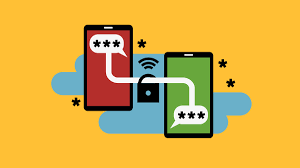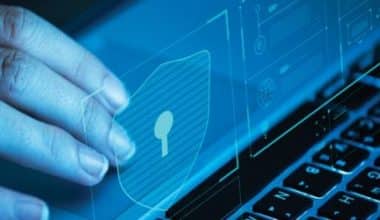In today’s digital world, our privacy is more important than ever. That’s why end-to-end encryption (E2EE) is becoming increasingly popular. E2EE is a type of encryption that ensures that only the sender and recipient of a message can read it. This means that even if someone intercepts the message in transit, they won’t be able to decrypt it.
In this article, we’ll discuss what E2EE is, how it works, and why it’s important. We’ll also look at some of the different ways that E2EE is being used today.
What is End-to-End Encryption
End-to-end encryption (E2EE) is a secure communication technique that makes it impossible for outsiders to access data while it is transported from one end system or device to another.
Only the intended recipient can decrypt the data in an end-to-end encryption transaction since it is encrypted on the sending system or device. The communication cannot be read or altered while in transit by an internet service provider (ISP), an application service provider, a hacker, or any other person, group, or service.
How Does End-to-End Encryption Work
The endpoints hold the cryptographic keys that are used to encrypt and decrypt the messages. In this method, public key encryption is used. A private key and a shared public key are used in public key encryption, also known as asymmetric encryption. When the public key is made available, anyone can use it to encrypt a message and send it to the public key’s owner. Only the associated private key, also known as the decryption key, can be used to decrypt the communication.
Online conversations nearly always include a third party passing messages back and forth between the persons participating in an exchange. This middleman is typically a server owned by an ISP, a telecommunications provider, or a number of other businesses. The public key infrastructure that E2EE utilizes prevents middlemen from intercepting messages in transit.
How to Utilize End-to-End Encryption
#1. Discreet Communication
End-to-end encryption is used by messaging apps like Signal and a digital trunked mobile radio protocol like TETRA to protect user conversations. Email systems can also be configured for end-to-end encryption, although this involves the implementation of the Pretty Good Privacy (PGP) encryption standard. Additionally, users can use PGP-integrated services like ProtonMail and Tutanota.
#2. Password Administration
End-to-end encryption is used to secure a user’s credentials by password managers like 1Password, BitWarden, Dashlane, and LastPass. But in this instance, the user is the only person with a key and is present on both endpoints.
#3. Storing Data
Storage units frequently offer E2EE while at rest. To protect customers’ data from third parties, including the cloud service provider, service providers can also offer E2EE in transit in a cloud storage environment.
What Does End-to-End Encryption Project Against
End-to-end encryption defends against these two dangers:
#1. Prickly Eyes
Only the sender and intended recipient know the keys to decrypt the message, so end-to-end encryption prevents anybody else from accessing the communication’s contents in transit. The message won’t be readable, even though a server acting as an intermediary server and facilitating its transmission may be able to see it.
#2. Tampering
End-to-end encryption additionally guards against the alteration of encrypted messages. Any attempts to change a message encrypted in this fashion would be obvious because there is no way to change it predictably.
What Does End-to-End Encryption Not Provide Protection
Despite the fact that the end-to-end encryption key exchange is thought to be impenetrable with current processing power and known methods, there have been numerous documented possible vulnerabilities of the encryption technique, including the following three:
#1. Metadata.
The fact that a message’s contents are protected by end-to-end encryption does not mean that the message’s sender, recipient, or other relevant information is hidden. When the information is decrypted, this metadata may provide malicious actors with the information they need to figure out where they can intercept it.
#2. Endpoint Compromises
An attacker could be able to read a message before it is encrypted or after it has been decoded if either endpoint has been hacked. Additionally, an attacker may use a stolen public key to launch a man-in-the-middle attack by retrieving keys from compromised endpoints.
#3. Vulnerable Middlemen
However, what they actually offer is more akin to encryption in transit, even though some companies claim to offer end-to-end encryption. The information might be kept on a third-party server that is accessible.
Advantages of End-to-End Encryption
End-to-end encryption’s key benefit is a high level of data privacy, which is made possible by the following characteristics:
#1. Security while Traveling
Public key cryptography, which keeps private keys on endpoint devices, is used for end-to-end encryption. Only those with access to the endpoint devices can read messages because only these keys can be used to decrypt messages.
#2. Tamper-Proof
With end-to-end encryption, the recipient will already have the decryption key, eliminating the need for transmission. A message encrypted with a public key cannot be edited or tampered with while in transit since the recipient cannot decrypt the message, making the manipulated contents invisible.
#3. Compliance
Regulatory compliance requirements that mandate data security at the level of encryption apply to many different industries. Organizations can protect the data by using end-to-end encryption to render it unreadable.
Disadvantages of End-to-End Encryption
End-to-end encryption generally does an excellent job of protecting digital communications, although data security is not guaranteed by it. The following are end-to-end encryption shortcomings:
#1. Complexity in the Endpoint Definition
At specific intervals during transmission, some end-to-end encryption implementations provide the decryption and re-encryption of the encrypted data. The communication circuit’s endpoints must be distinct and clearly defined as a result.
#2. A Surplus of Privacy
Since service providers can’t give law enforcement access to the content, government and law enforcement organizations worry that end-to-end encryption would shield users who share illegal content.
#3. Accessible Metadata
Although information about the communication, such as the date it was delivered and the receiver, is still accessible even if it is encrypted and impossible to read, this information could be beneficial to a trespasser.
#4. Endpoint Protection
Encrypted data could be exposed if endpoints are exploited.
Not foreseeable. Although end-to-end encryption is a reliable technique at the moment, it is predicted that cryptography will soon be superseded by quantum computing.
Programs that Make Use of End to End Encryption
Pretty Good Privacy was the first widely used end-to-end encryption messaging program that protected email, saved files, and employed digital signatures. End-to-end encryption is often used in text messaging services like Apple’s iMessage, Jabber, and Signal Protocol (formerly known as TextSecure Protocol). End to end encryption protocols are also used by POS service providers like Square to provide PCI compliance.
Facebook declared that all three of its messaging services would start utilizing E2EE in 2019. Law enforcement and intelligence organizations counter that encryption makes it more difficult for Facebook to monitor illicit activity on its platforms. The discussion frequently centres on how E2EE might make it more challenging to spot and stop child abuse on private messaging networks.
What Distinguishes End-to-End Encryption from Other Kinds of Encryption
Only the endpoints — the sender and the recipient — are able to decrypt and read the communication, which distinguishes end-to-end encryption from other encryption techniques. Symmetric key encryption, commonly referred to as single-key or secret key encryption, offers a continuous layer of encryption from sender to recipient but encrypts data with just one key.
A password, code, or string of randomly generated numbers can be used as the single-key encryption key, which is provided to the message receiver and utilized to decrypt the message. When being passed from sender to receiver by intermediaries, it could appear complex and like gibberish. No matter how much one key modifies the message, if a third party obtains the key, the communication can still be intercepted, decoded, and read. End-to-end encryption prevents intermediates from accessing the key and decrypting the communication thanks to its two keys.
What is End to End Encryption Data
You might get a warning advising you to reset end-to-end encrypted data when you first set up a new iPhone. When the iPhone is not authorized by another device, a notification appears. “Can’t approve this iPhone?” reads the notification. Reset Encrypted Data is a selection that is available. Continue reading to discover more about the function and what to do if you receive this message.
What is Data that is End-to-End Encrypted
Apple has implemented this security measure to help safeguard your data. Using a key, data can be sent to another user in an encrypted format. Additionally, this feature necessitates the setup of two-factor authentication on a different, trusted device.
Many users are concerned that wiping this feature will delete their music, images, and other data. Your phone will continue to be loaded with your personal content. End-to-end encryption data can be reset, but it may also remove things like search histories, passwords, iCloud communications, health information, Apple Card transactions, Siri information, and iCloud keychain.
In the QuickType Keyboard, you may store information about your house, notes, payments, and terminology.
You can back up items like messages to iCloud in order to preserve them. You should completely back up your iPhone in case you also need to do this.
A Decision on an iPhone
It’s possible that you did not approve the device from your iCloud account, which is why this notification appears. You would then need to sign into your iCloud account and authorize the device that is displaying the notification.
In order to authorize a new device in iCloud:
- .Log in to iCloud with the authorized device.
- Try logging into iCloud with the unauthorized phone.
- If an unauthorized device tries to log in, you should receive a notification on your authorized device asking you to grant permission. Choose to Allow. Enter the verification code for your Apple ID.
- The data ought to automatically sync after a while.
How to disable Two-Factor Authentication
You could attempt to disable two-factor authentication. You must log in to your Apple ID account page in order to disable two-factor authentication. Select Account Security from the security menu. From there, you can disable two-factor authentication.
End-to-End Encrypted Data Reset Procedure
Try resetting the end-to-end encrypted data if you don’t want to disable two-factor authentication or if it is not working. The Reset Encrypted Data option on the message that appears is typically all that is necessary.
End-to-End Encryption Messanger
End-to-end encryption on Messenger gives your messages and calls additional security and protection so that only you and the person you’re speaking to can see, hear, or read them.
Also, encrypted conversations protect the content of your texts and call from the minute it leaves your device until it reaches the recipient’s device.
This implies that no one else, not even Meta, can see or hear what is sent or said. Even if we wanted to, we couldn’t.
How Your Chat is Protected with End-to-End Encryption
An end-to-end encrypted discussion is protected by a unique key that is shared among all participating devices. Your device locks the message while it is being sent when you send it in a conversation that is end-to-end encrypted. Only a device that has one of the conversation’s keys can unlock this message.
Only the owners of the keys can access your calls or texts. In end-to-end encrypted chats, only you and the other party have specific, matching keys. To ensure the security of your discussion, you can verify that your keys match:
- Check your Messenger keys.
- Check the Portal for your keys.
Encryption from End to End and Web Browsers
Your communications are saved in the device’s browser (for instance, Chrome) when you transmit encrypted messages over the internet. Your browser may remove the messages from its storage if you erase your browser’s cookies or browse in private mode.
Those messages might no longer be visible in the Messenger chat on that browser.
If you use a different browser on the same device, you might not get the notifications.
End-to-End Encryption WhatsApp
We incorporated end-to-end encryption into our app because privacy and security are ingrained in our DNA. Your calls, texts, papers, status updates, and other content is protected from leaking into the wrong hands when they are end-to-end encrypted.
#1. Individual Messaging
When you use WhatsApp Messenger to chat with someone else, end-to-end encryption is employed. With end-to-end encryption, you can be sure that no third party, not even WhatsApp, will be able to read or listen to the messages you send. This is due to the fact that end-to-end encryption secures your messages with a lock that only you and the recipient have the unique key to open and read. There is no need to activate any additional settings to secure your messages because everything is done automatically.
#2. Enterprise Messaging
The same Signal encryption mechanism that secures communications before they leave your smartphone is used to protect every WhatsApp message. Your message is safely delivered to the recipient selected by the business when you message a WhatsApp business account.
Chats with businesses that make use of the WhatsApp Business app or who handle and store customer communications themselves are regarded by WhatsApp as being end-to-end encrypted. The message will be subject to the company’s own privacy policies after it has been received. To process and react to the message, the company may assign a number of personnel or even other vendors.
#3. Payments
Transfers between accounts at financial institutions are possible with the help of WhatsApp payments, which are accessible in a few countries. Bank and credit card numbers are encrypted and kept on a highly secure network. These transfers are not end-to-end encrypted, though, because financial institutions cannot execute transactions without obtaining information about them.
End-to-End Encryption Instagram
In an end-to-end encrypted conversation, the content of your messages and calls is secure from the minute it leaves your device until it reaches the recipient’s device.
This indicates that no one, not even Meta, can see or hear what is sent or uttered during this delivery.
Instagram for iPhone and Android allows you to start an encrypted conversation.
- Tap on the Feed’s upper-right corner.
- Tap the upper right corner.
- Press the button to begin an end-to-end encrypted chat.
- Either choose the individuals you wish to begin an end-to-end encrypted chat with or use the top search bar to find their names.
- Tap Chat in the top right corner.
You’ll observe end-to-end encrypted talks. Your Chats list will show separate chats for any further talks you have with the same folks that aren’t part of this one.
What is an Example of End-to-End Encryption?
Ken wants to receive an encrypted communication from Cynthia. She encrypts a message to Ken using his public key. The communication is then decrypted by Ken using his private key on the device when he receives it from Cynthia.
How do I get my End-to-End Encryption?
To access end-to-end encryption for your conversations, open the conversations settings and turn on RCS chats or Chat features. By looking for a tiny padlock next to the send button, you may verify that it is functioning.
Can You Crack End-to-End Encryption?
Unfortunately, everything is vulnerable to hacking, even end-to-end encryption. It will happen in due course. End-to-end encryption is fantastic because, although it can be compromised, it would take hundreds or even thousands of years to do so.
Does iPhone have End-to-End Encryption?
FaceTime, Mail, and Messages. Your FaceTime and iMessage chats are end-to-end encrypted, making it impossible to read them as they travel between devices. Mail enables anonymity.
How Do I Read an End-to-End Encryption Text Message?
Text messages appear in light blue for SMS/MMS and dark blue for RCS.
You’ll see a banner that reads “Chatting with [contact name or phone number]” when end-to-end encryption is engaged in a chat. End-to-end encryption is automatic in qualifying conversations. There will be a lock on the send button for your communications as well. End-to-end encrypted messages also have a lock on their timestamps.
Why would Someone Turn in End-to-End Encryption?
Your conversations are safe using end-to-end encryption as a security measure. End-to-end encryption prevents anybody from reading eligible communications as they move between your phone and the phone your message, including Google and outside companies.
Conclusion
Using a technique to convert common text characters into an unreadable format is known as data encryption. To clarify, this procedure scrambles data using encryption keys so that only authorized users may decipher it. This method is also used for end-to-end encryption. By safeguarding connections between different endpoints, it goes a step further.
Related Articles
- BACK END DEVELOPER: Definition & All You Need to Know
- FILE ENCRYPTION: All You Need to Know
- The Future of BTC Gambling Sites: Emerging Trends and Technologies to Watch
- ENCRYPT: How to Encrypt an Email & Free Tips
- How to Send and Receive Faxes Online






